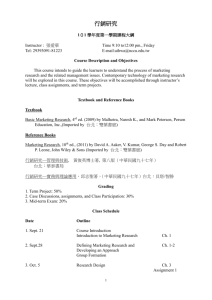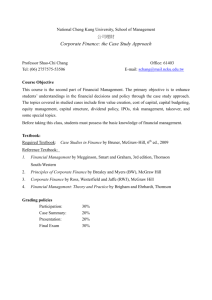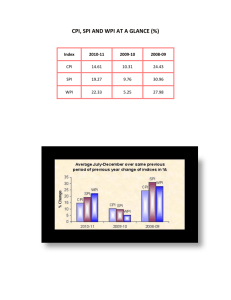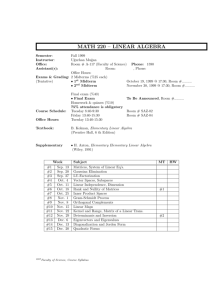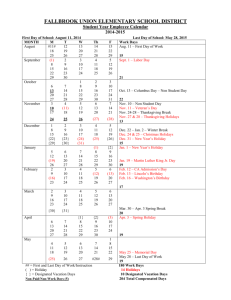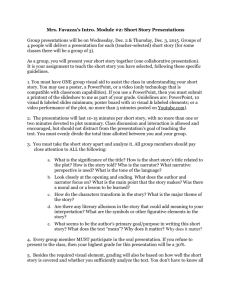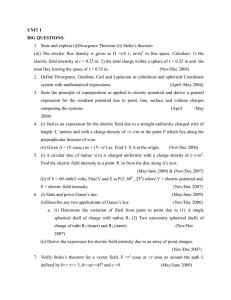UNIT I BIG QUESTIONS: State and explain (i)Divergence Theorem
advertisement
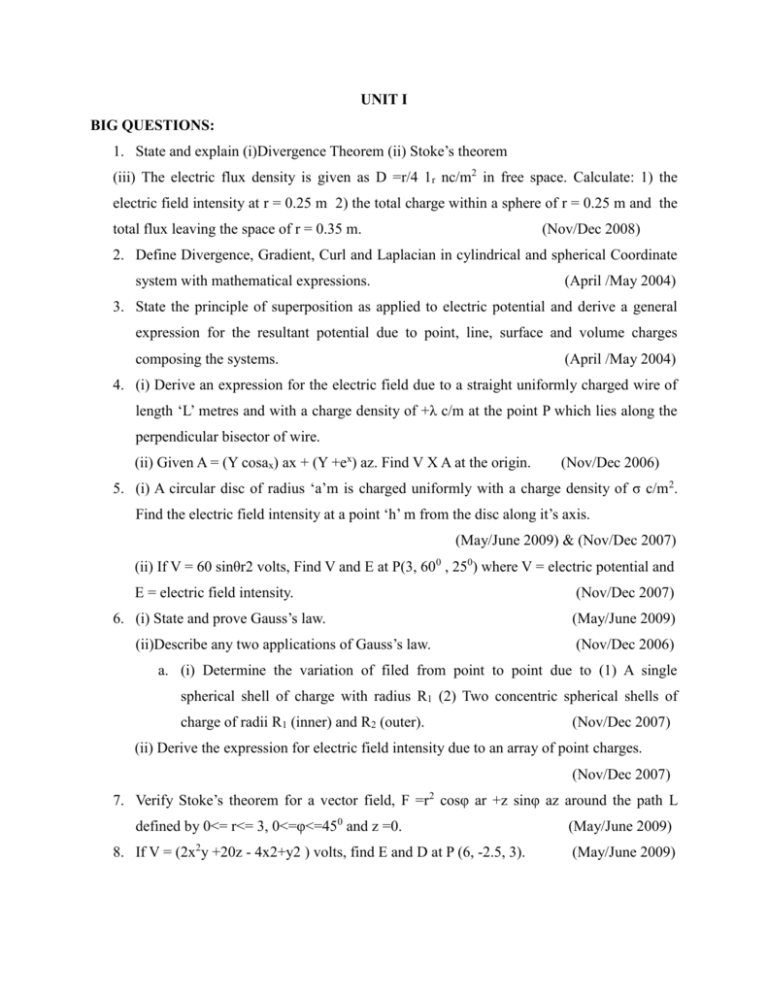
UNIT I BIG QUESTIONS: 1. State and explain (i)Divergence Theorem (ii) Stoke’s theorem (iii) The electric flux density is given as D =r/4 1r nc/m2 in free space. Calculate: 1) the electric field intensity at r = 0.25 m 2) the total charge within a sphere of r = 0.25 m and the total flux leaving the space of r = 0.35 m. (Nov/Dec 2008) 2. Define Divergence, Gradient, Curl and Laplacian in cylindrical and spherical Coordinate system with mathematical expressions. (April /May 2004) 3. State the principle of superposition as applied to electric potential and derive a general expression for the resultant potential due to point, line, surface and volume charges composing the systems. (April /May 2004) 4. (i) Derive an expression for the electric field due to a straight uniformly charged wire of length ‘L’ metres and with a charge density of +λ c/m at the point P which lies along the perpendicular bisector of wire. (ii) Given A = (Y cosax) ax + (Y +ex) az. Find V X A at the origin. (Nov/Dec 2006) 5. (i) A circular disc of radius ‘a’m is charged uniformly with a charge density of σ c/m 2. Find the electric field intensity at a point ‘h’ m from the disc along it’s axis. (May/June 2009) & (Nov/Dec 2007) (ii) If V = 60 sinθr2 volts, Find V and E at P(3, 600 , 250) where V = electric potential and E = electric field intensity. 6. (i) State and prove Gauss’s law. (ii)Describe any two applications of Gauss’s law. (Nov/Dec 2007) (May/June 2009) (Nov/Dec 2006) a. (i) Determine the variation of filed from point to point due to (1) A single spherical shell of charge with radius R1 (2) Two concentric spherical shells of charge of radii R1 (inner) and R2 (outer). (Nov/Dec 2007) (ii) Derive the expression for electric field intensity due to an array of point charges. (Nov/Dec 2007) 7. Verify Stoke’s theorem for a vector field, F =r2 cosφ ar +z sinφ az around the path L defined by 0<= r<= 3, 0<=φ<=450 and z =0. 8. If V = (2x2y +20z - 4x2+y2 ) volts, find E and D at P (6, -2.5, 3). (May/June 2009) (May/June 2009) 9. (i) Determine the electric field intensity of an infinitely long, straight, line charge of a uniform density ρλ in air. (Nov/Dec 2008) & (Nov/Dec 2003) (ii) Determine Electric field intensity at P (1,2,5) due to a point charge of 10nc at Q(1,-2,3). (Nov/Dec 2008) 10. (i) Explain potential due to charged disc. (ii) Three charged cylindrical sheets are present in three spaces with σ = 5C/m 2 at R = 2m σ = -2C/m2 at R = 4m & σ = -3C/m2 at R = 5m. Find flux density at R = 1, 3, 4, 5 & 6 m. (April /May 2008) 11. (i) Explain the electric field due to ‘n’ number of charges. (April /May 2008) (ii) A uniform line charge of 1nC is situated along x-axis between the points (-500, 0) and (500, 0) mm. Find the electric scalar potential at (0,1000) mm. (April /May 2005) 12. (i) State super position theorem in relevance to field theory and derive the equation for total electric field intensity. (Nov/Dec 2006) (ii) Consider two point charges Q1 =8πε0 coulombs and Q2= -4 πε0 coulombs situated at (-1, 0, 0) m respectively. Find the electric field intensity at the point (0, 0, 1). Draw the phasor diagram. (Nov/Dec 2006) 13. (i) Let, A =5ax, and B = 4 ax+By ay, Find by such that, angle between , A and , B is 450. If, B also has a term Bz az, what relationship must exist between by By and Bz. (ii) A uniform line charge ρL = 25nC/m lies on the line, x= -3m and y= 4m, in free space. Find the electric field intensity at a point (2, 3, 15) m. (May/June 2006) 14. (i) If two vectors are expressed in cylindrical coordinates as A = 2ax +π ay +az B = -ax+3π/2 ay -2azCompute a unit vector perpendicular to the plane containing A and B. (ii) A regular tetrahedron has vertices at P1 (2, 0, 0) . P2(-1, √3, 0), P3(-1, -√3, 0) , P4(0, 0, 2√2). Charges of 1mC are located at each of the four vertices. If the configuration is located in free space, find the magnitude of force on each charge. (May/June 2007)
